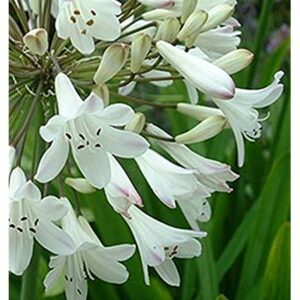Description
Garden Advice Notes
Echinops Taplow Blue is a herbaceous perennial plant that is part of the Asteraceae family. It is a cultivar of the Echinops genus, commonly known as Globe Thistles, and is named after the village of Taplow in Buckinghamshire, England.
The plant features silver-green foliage that forms a basal rosette, with tall, upright stems that can reach up to 1.5 meters in height. The stems bear large, round, blue-gray flower heads that are approximately 5-6 centimeters in diameter. These flower heads are made up of numerous small, tubular flowers that are surrounded by sharp spines, giving the plant a unique and attractive appearance.
Echinops Taplow Blue is known for its long flowering period, with blooms appearing in mid-summer and lasting until early autumn. It is a hardy plant that can tolerate a range of soil conditions and is relatively easy to grow, making it a popular choice for gardeners looking to add some height and interest to their borders or as cut flowers for floral arrangements.
Soil type-Echinops Taplow Blue is a relatively adaptable plant when it comes to soil types, but it prefers well-draining soils that are not too rich or fertile. A loamy or sandy soil with a neutral to slightly alkaline pH between 6.5 and 7.5 is ideal.
It is important that the soil is not too wet or heavy, as this can cause root rot and other issues. To improve drainage, you can amend heavy soils with organic matter like compost or well-rotted manure.
Location-Echinops Taplow Blue is a hardy plant that can grow in a wide range of locations, but it thrives best in areas with a temperate climate. It is native to central and southern Europe and can tolerate cold temperatures down to USDA hardiness zone 4 (-30°F/-34°C) and higher.
The plant prefers full sun to partial shade and is well-suited for growing in a variety of locations, including borders, meadows, and cottage gardens. It also makes an excellent cut flower for floral arrangements.
Pest and disease problems-Echinops Taplow Blue is generally a low-maintenance plant that is relatively resistant to pests and diseases. However, like all plants, it can be affected by a few issues.
Some of the potential pest problems include aphids, spider mites, and thrips, which can be controlled with insecticidal soap or neem oil. The plant may also be susceptible to slug and snail damage, which can be prevented by using slug and snail bait or by handpicking the pests.
Regarding diseases, Echinops Taplow Blue can be susceptible to root rot if planted in poorly-drained soil, so it is essential to ensure that the soil is well-draining. Additionally, the plant may develop powdery mildew, particularly in humid conditions or if planted too close together, but this can be controlled with fungicides or by spacing the plants further apart to improve air circulation.
It is essential to note that while Echinops Taplow Blue can face these problems, they are not common, and the plant is generally very robust and easy to care for.
- Seed propagation: Sow the seeds in a seed tray or individual pots in spring. Cover the seeds with a thin layer of soil and keep them moist until they germinate, which typically takes 2-3 weeks. Once the seedlings have developed two true leaves, they can be transplanted into individual pots or into the garden.
- Division: Divide established clumps of Echinops Taplow Blue in spring or autumn. Carefully dig up the clump and separate it into smaller sections, ensuring that each section has roots attached. Replant the divisions in well-draining soil, spacing them at least 30-60cm apart.
When propagating Echinops Taplow Blue, it is essential to ensure that the soil is well-draining and that the plants are kept moist but not waterlogged until they become established. Once established, Echinops Taplow Blue is a low-maintenance plant that can grow for many years with minimal care.
Pruning, cutting back and dividing-Echinops Taplow Blue is a relatively low-maintenance plant that does not require much pruning or cutting back. However, some light maintenance can help promote healthy growth and prolong its lifespan. Here are some tips on pruning, cutting back, and dividing Echinops Taplow Blue:
- Pruning: Deadhead the spent flowers as they fade to promote continuous blooming and to prevent the plant from self-seeding. You can do this by snipping off the spent flowers with a pair of pruning shears or by cutting the entire flower stalk back to the base of the plant.
- Cutting back: In autumn, after the flowers have finished blooming, you can cut the entire plant back to just above ground level. This helps to keep the plant tidy and encourages new growth in the following season.
- Dividing: Echinops Taplow Blue can be divided every few years in spring or autumn to rejuvenate older plants and to create new plants for your garden. Dig up the clump and use a sharp spade or knife to separate it into smaller sections, ensuring that each section has roots attached. Replant the divisions in well-draining soil, spacing them at least 30-60cm apart.
By following these simple maintenance tasks, you can help keep your Echinops Taplow Blue healthy and vibrant for many years to come.
Our plants are guaranteed for 24 months for more details Click Here

























Reviews
There are no reviews yet.